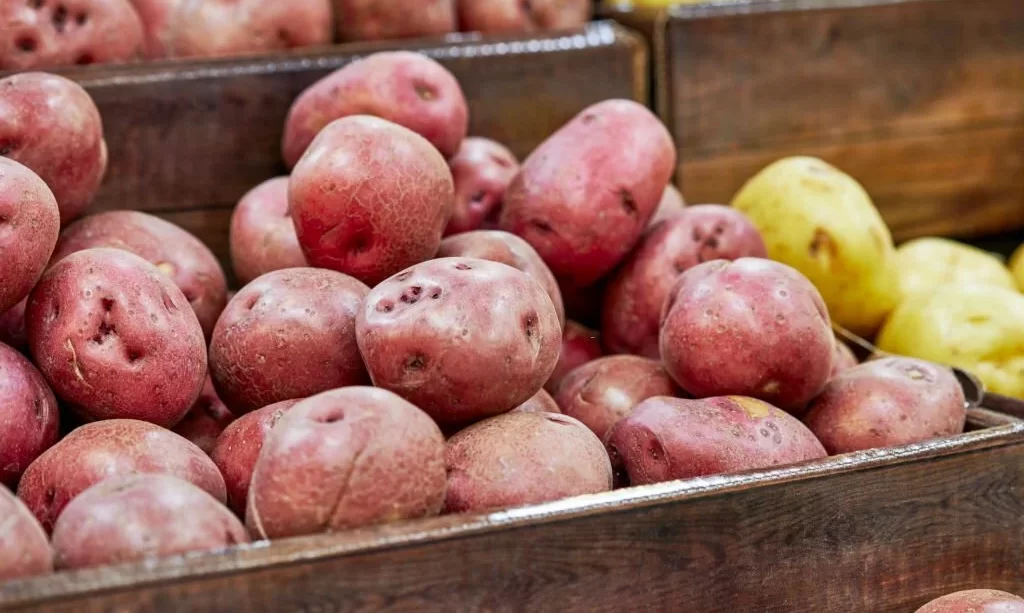Red potatoes, with their vibrant hues and delectable taste, have long been a beloved presence in kitchens around the world. Yet, amidst their culinary popularity, a persistent misconception lingers – the belief that red potatoes are artificially dyed to achieve their characteristic crimson coloring. This intriguing culinary myth calls for a closer look. In this exploration, we will unravel the mystery surrounding red potatoes and address the prevailing question: Are red potatoes truly dyed, or do they naturally exhibit this vibrant appearance? To uncover the truth, we will begin by examining the natural varieties and characteristics of red potatoes, dispelling any doubts about their authenticity.
- Red potatoes have a light, subtly sweet flavor
- Excellent for roasting, grilling, mashing and salads
Red Potatoes: Natural Varieties and Characteristics
Red potatoes are not the product of artificial manipulation; rather, they are a testament to the remarkable diversity within the potato family. These potatoes encompass natural varieties with distinct characteristics, making them a unique and genuine addition to the culinary landscape. Red potatoes are characterized by their vibrant red or pink skin, often encasing white, yellow, or red flesh. These colors are not the result of artificial dyes but instead occur naturally, varying in intensity across different potato varieties. The appeal of red potatoes lies in their earthy flavor and waxy texture, which makes them ideal for an array of culinary applications, from crispy roasted potatoes to creamy potato salads.
The Culinary Role of Red Potatoes
Red potatoes play a prominent role in the world of cooking, offering a range of delightful attributes that make them a sought-after ingredient. Their waxy texture, less starchy than other potato varieties, ensures that they hold their shape well when cooked. This quality is particularly valuable in dishes like potato salads, where they maintain their integrity and lend a pleasing bite. The colorful skin of red potatoes adds a vibrant touch to dishes, making them visually appealing. Their distinct flavor, often described as slightly nutty or earthy, complements various seasonings and pairings. Whether roasted, mashed, boiled, or used in stews and soups, red potatoes bring both aesthetic and culinary value to a wide array of recipes. Understanding the genuine nature of red potatoes and their role in the kitchen is essential in dispelling the myth that they are artificially dyed.
- perfect for an array of uses
- Fresh from Florida
- Florida Grown
- good for baking
- High in Vitamin C
Debunking the Myth: Red Potatoes and Artificial Dyes
The myth that red potatoes are artificially dyed is precisely that—a myth. Red potatoes achieve their vivid hues through natural processes rather than artificial intervention. There is no need for dyes or colorants to attain the beautiful crimson and pink shades that define these spuds. In fact, attempts to dye red potatoes would be futile since the color is deeply ingrained in their genetic makeup. The belief that red potatoes are artificially altered likely arises from the striking contrast between their colorful skin and the predominantly white or yellow flesh, creating an eye-catching visual effect. However, the captivating coloration of red potatoes is entirely authentic, and the answer to their rich pigmentation lies in the world of plant pigments.
The Role of Anthocyanins in Red Potatoes
The captivating red and purple hues of red potatoes are the result of natural pigments called anthocyanins. Anthocyanins are a class of water-soluble pigments found in various fruits and vegetables, renowned for their antioxidant properties and potential health benefits. In red potatoes, these pigments are primarily concentrated in the potato skin, although they may extend to the flesh in some varieties. The presence of anthocyanins not only contributes to the striking appearance of red potatoes but also offers a potential nutritional advantage. These antioxidants may play a role in protecting the plant from environmental stress and UV radiation, while also providing human consumers with a dose of naturally occurring health-promoting compounds.
Cultivation and Growing Conditions
The intensity of red potato coloration can be influenced by factors such as soil type, climate, and temperature. Different growing conditions and regions may yield red potatoes with variations in color intensity. While these factors can impact the final appearance of red potatoes, it’s important to note that these variations occur naturally, without any artificial dyes or color enhancements. Once harvested and cooked, red potatoes retain their distinctive colors, reinforcing the authenticity of their appearance.
Conclusion
In conclusion, the myth that red potatoes are artificially dyed is debunked by a clear understanding of the natural varieties and characteristics of these spuds. The rich red and pink hues that define red potatoes are not the product of artificial colorants but instead arise from the presence of anthocyanin pigments. These compounds offer both a stunning appearance and potential health benefits. The variations in color intensity, influenced by growing conditions, are natural and do not involve any artificial interventions. Red potatoes are a genuine and valuable addition to the culinary world, celebrated for their flavor, texture, and natural coloring. The next time you enjoy a plate of red potatoes, you can savor them with confidence, knowing that their appealing appearance is the result of nature’s artistry, not artificial enhancement.





